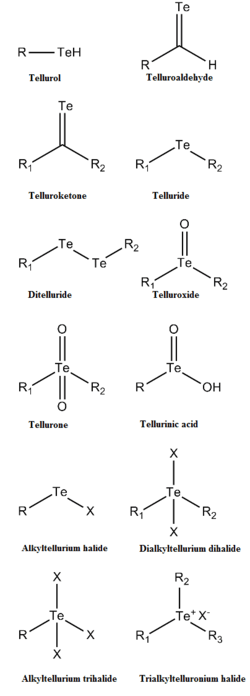Organotellurium chemistry
Organotellurium chemistry in chemistry describes the synthesis and properties of chemical compounds containing a carbon to tellurium chemical bond.[1] Organotellurium chemistry was developed in the wake of organoselenium chemistry and, sharing the same group in the periodic table, both chemistries have much in common.
Functional groups

The Te analogues of common organosulfur functional groups are known. Tellurols are unstable. Diorganomono- and ditellurides are the most commonly encountered organotellurium compounds. Telluroxides (R2TeO) are also known.
Synthesis
Commonly used tellurium based reagents are hydrogen telluride, NaHTe, sodium telluride, and PhTeLi. Because Te is insoluble and polymeric, it is often not a useful precursor to organotellurium compounds, but it is attacked by hydride reducing agents:
- Te + 2LiBHEt3 → Li2Te + H2 + 2 BEt3
and organolithium compounds:
- Te + RLi → RTeLi
One departure from S and Se chemistry, is the availability of the tetrachloride TeCl4.[2] Tellurium tetrachloride reacts with alkenes and alkynes to the chloro tellurium trichloride addition product:
- RCH=CH2 + TeCl4 → RCH(Cl)-CH2TeCl3
These organotellurium derivatives are susceptible to further reactions.
Applications
Organotellurium compounds have few applications. Dimethyl telluride is used to in the metalorganic vapour phase epitaxy where it serves as a volatile source of Te. It is the only organotellurium compound that has been quantified in environmental samples.[3]
Organic synthesis
Diphenyl ditelluride is used as a source of PhTe− in organic synthesis. Some of its reactions are:
- Organic reduction of aldehydes, alkenes, alkynes, nitro compounds, oxiranes to alkenes
- Debromination of vicinal dibromides with E2 elimination
Other methods in organotellurium chemistry include:
- Tellurium in vinylic tellurium trichlorides can be replaced by halides with a variety of reagents (iodine, NBS)
- Detellurative cross-coupling reaction: Compounds of the type Ar2TeCl2 engage in a coupling reaction to the corresponding biaryls with Raney nickel or palladium[4]
- Another type is this Stille reaction:[5]

- Hydrotelluration: Compounds of the type RTeH react with alkynes R'CCH to R'HCCTeR with anti addition to a Z-alkene. In contrast hydrostannylation, hydrozirconation and hydroalumination in similar reactions react with syn addition.
- Te/Li exchange in transmetallation[6] is used in the synthesis of lithium reagents with demanding functional groups.
- Allylic oxidation: like the selenium counterpart selenoxide oxidation, allylic telluroxides undergo [2,3]-sigmatropic rearrangements forming allylic alcohols after hydrolysis.
- Olefin synthesis: Like the selenium counterpart selenoxide elimination, certain telluroxides (RTeOR) can form alkenes on heating.
See also
- The chemistry of carbon bonded to other elements in the periodic table:
| Compounds of carbon with other elements in the periodic table | |||||||||||||||||||||||||||||||||||||||||||||||||||||||||||||||||||||||||||||||||||||||||||||||||||||||||||||||||||||||||||||||||||||||||||||||||||||||||||||||||
|---|---|---|---|---|---|---|---|---|---|---|---|---|---|---|---|---|---|---|---|---|---|---|---|---|---|---|---|---|---|---|---|---|---|---|---|---|---|---|---|---|---|---|---|---|---|---|---|---|---|---|---|---|---|---|---|---|---|---|---|---|---|---|---|---|---|---|---|---|---|---|---|---|---|---|---|---|---|---|---|---|---|---|---|---|---|---|---|---|---|---|---|---|---|---|---|---|---|---|---|---|---|---|---|---|---|---|---|---|---|---|---|---|---|---|---|---|---|---|---|---|---|---|---|---|---|---|---|---|---|---|---|---|---|---|---|---|---|---|---|---|---|---|---|---|---|---|---|---|---|---|---|---|---|---|---|---|---|---|---|---|---|
| |||||||||||||||||||||||||||||||||||||||||||||||||||||||||||||||||||||||||||||||||||||||||||||||||||||||||||||||||||||||||||||||||||||||||||||||||||||||||||||||||
References
- ↑ Nicola Petragnani, Tellurium in Organic Synthesiss 1994, Academic Press, New York. ISBN 0-12-552810-8
- ↑ Lars Engman, "Tellurium(IV) Chloride" E-EROS. 2001. doi:10.1002/047084289X.rt003
- ↑ Wallschläger, D.; Feldmann, F. (2010). Formation, Occurrence, Significance, and Analysis of Organoselenium and Organotellurium Compounds in the Environment. Metal Ions in Life Sciences. 7, Organometallics in Environment and Toxicology. RSC Publishing. pp. 319–364. ISBN 978-1-84755-177-1.
- ↑ For an example see: Organic Syntheses, Coll. Vol. 6, p.468 (1988); Vol. 57, p.18 (1977). http://orgsynth.org/orgsyn/pdfs/CV6P0468.pdf
- ↑ Palladium- and copper-catalyzed cross-coupling and carbonylative cross-coupling of organotellurium compounds with organostannanes (Chem. Commun. 1999, 2117) - Royal Society of Chemistry Suk-Ku Kang, Sang-Woo Lee and Hyung-Chul Ryu Link
- ↑ For an example see: Organic Syntheses, Coll. Vol. 9, p.234 (1998); Vol. 72, p.154 (1995). http://orgsynth.org/orgsyn/pdfs/CV9P0234.pdf